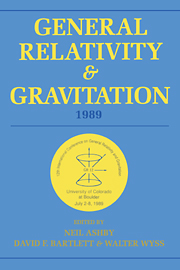 General Relativity and Gravitation, 1989
General Relativity and Gravitation, 1989 Published online by Cambridge University Press: 05 March 2012
Inflationary supercomputing
There are many problems in numerical relativity. From a view point of asymptotic behavior of space-times they are divided into three categories as:
V: Vacuum space-times;
AF: Asymptotically flat space-times with matter;
ANF: Asymptotically non-flat space-times with matter.
On the other hand from a view point of dimension of the problem they are divided into another three categories as:
ID: A problem in which all the physical quantities depend on one spatial coordinate x1 and the time t;
2D: A problem in which all the physical quantities depend on two spatial coordinates x1 and x2 and the time t;
3D: A problem in which all the physical quantities depend on three spatial coordinates x1, x2 and x3 and the time t.
Every problem can be characterized according to these two classifications. For example, the two black hole collision calculated by Smarr belongs to V-2D. There are also many numerical methods for each problem. They include the characteristic method, Regge calculus, finite element method, finite difference method, spectral method, particle method and so on. Moreover the choice of coordinate conditions is not usually unique for each method. Therefore there are a tremendous variety of possibilities for each author's problem. In reality there are up to 30 papers on numerical relativity in this conference which are reviewed by Centrella in this volume.
One of the main factors, however, which determines progress in numerical relativity is the power of available computers.
To save this book to your Kindle, first ensure [email protected] is added to your Approved Personal Document E-mail List under your Personal Document Settings on the Manage Your Content and Devices page of your Amazon account. Then enter the ‘name’ part of your Kindle email address below. Find out more about saving to your Kindle.
Note you can select to save to either the @free.kindle.com or @kindle.com variations. ‘@free.kindle.com’ emails are free but can only be saved to your device when it is connected to wi-fi. ‘@kindle.com’ emails can be delivered even when you are not connected to wi-fi, but note that service fees apply.
Find out more about the Kindle Personal Document Service.
To save content items to your account, please confirm that you agree to abide by our usage policies. If this is the first time you use this feature, you will be asked to authorise Cambridge Core to connect with your account. Find out more about saving content to Dropbox.
To save content items to your account, please confirm that you agree to abide by our usage policies. If this is the first time you use this feature, you will be asked to authorise Cambridge Core to connect with your account. Find out more about saving content to Google Drive.